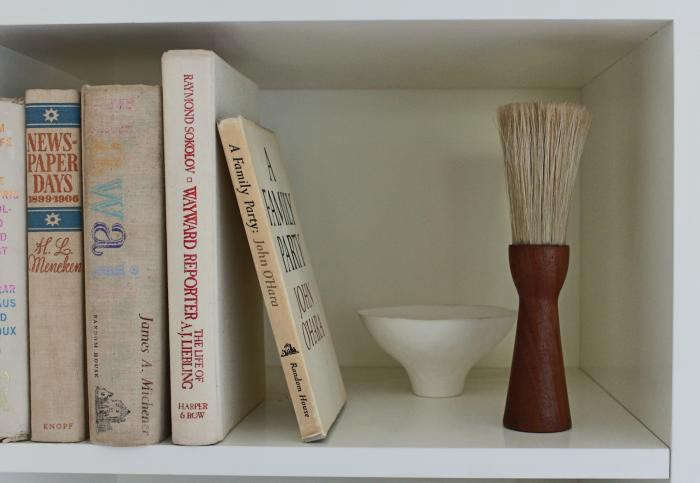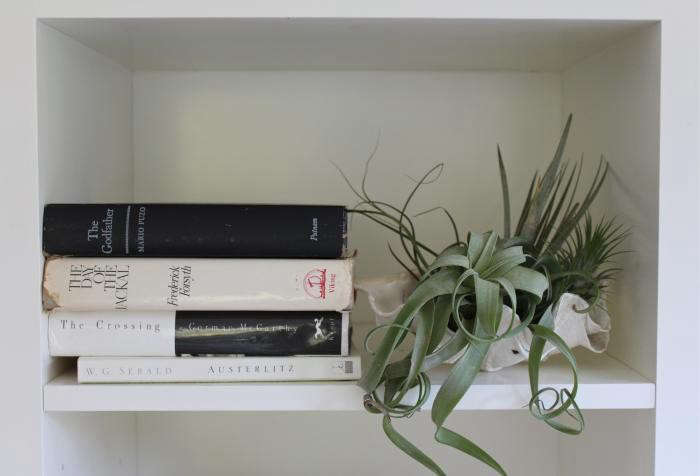
I don’t have anything against the idea of TV; in fact, I consider TV to be the new novel. When I power-watch three or four—OK, five—episodes, I get the same woozy, drugged-out high as from being lost in a book. What I hate is how a TV looks, a black hole on the wall trying to suck light out of a whole universe. Plus, it has ugly sidekicks skulking around: modems, woofers, blinky black boxes, and cords. Here’s how to fix those problems:
Photography by Michelle Slatalla.

Secret No. 1:
To minimize the TV’s hulkiness, Stephanie surrounded it with deep bookshelves. The screen sits flush with the front of the shelves, making the TV seem barely three-dimensional and no more obtrusive than, say, a chalkboard.
Secret No. 2:
The TV is surrounded by a generously sized, five-inch-wide frame with a beveled edge, like a picture frame, further diminishing the screen. (The frame is attached by magnets and pops off so my husband can rummage around behind it with cords, etc.).
Secret No. 3:
Notice how the whole wall—shelves, cabinetry, frame—is painted a single neutral, light color. This further downplays the TV, which is mounted on an arm against a false wall that’s shallower than the wall behind the surrounding bookshelves; cords attached to the TV drop behind it into the cabinets below.
Secret No. 4:
Put all that horrible TV-related stuff inside cabinets, and put vented doors on the front so the electronics don’t overheat. Beneath the TV, Stephanie designed doors with Octagon Cane Decorative Perforated Metal.

Secret No. 5:
Put all the electronic components on pullout drawers so it’s easy to get to the cords at the back. Our TV is attached to a receiver that’s connected to a set of five surround-sound speakers including a subwoofer the size of a dorm refrigerator; a router; a Blu-Ray DVD player; a Sonos hi-fi system bridge, and an Apple TV. I don’t know what any of these things are—my husband insisted we “needed” them—but I am happy I cannot see them. They live inside these cabinets.
There is a messy tangle of cords attendant to any entertainment center setup; I put a few books on the bottom shelf to hide the cords (and the power strip to which they are attached).
Secret No. 6:
Let your furniture help you hide the cords. At my house, the power strip hides between two pieces of my sectional sofa.
In the family room, we lounge around a lot on the sectional with our computers (sometimes while simultaneously watching TV—sick, I know). Where the two pieces of my sectional meet, a power strip lurks beneath on the floor. You can pull up a cell phone charger, an iPad cord, possibly even the charger to my husband’s electric shaver. There’s a lot hidden under the cushions.

If you don’t have a sectional, you still may be able to accomplish this neat trick. Simply attach your power cords to a power strip that sits on the floor behind the sofa, and thread the cords up through cushions or unobtrusively up the side of an arm.
Secret No. 7:
Maintain some electronics-free zones in the family room. On my bookshelves are, well, books. And plants. Can’t you just feel all that oxygen coursing into the room? Empty white space is a design element that makes the area around the TV set feel more open and spacious.
And now? I still have a few episodes of House of Cards (the British version—I finished power-watching Kevin Spacey and Robin Wright last week) to catch up on. Reminds me of Bleak House.
Emboldened to rid your life of all cords once and for all? Miracles do exist. See 5 Ways to Banish Computer Cords from Your Home Office over on Remodelista.










Have a Question or Comment About This Post?